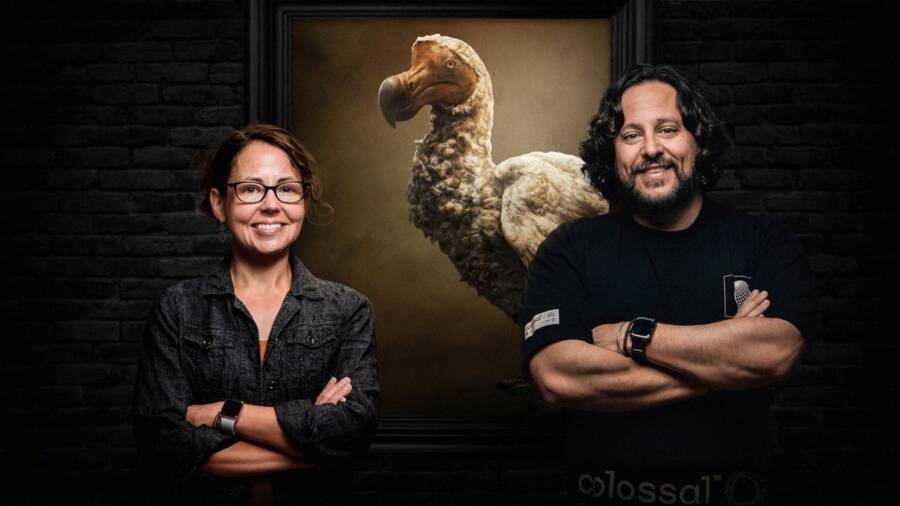Scientists believe that a version of the extinct dodo could be replicated but some argue that the money and time required to do so would be better spent protecting at-risk species today.

Becker/Fox Photos/Getty ImagesA dodo skeleton with an approximate recreation of the extinct bird at the National Museum of Wales, Cardiff. 1938.
Hundreds of years ago, the last dodo died and the species vanished from the Earth. But a biotechnology and genetic engineering start-up called Colossal Biosciences hopes to bring the lost bird back.
The company, which is also working on ambitious projects to revive the woolly mammoth and the Tasmanian tiger, believes that bringing the dodo back could have far-reaching implications. Not only would the project bring awareness to other species threatened by extinction, but it could also develop gene therapy techniques to help at-risk animals.
“We’re clearly in the middle of an extinction crisis,” Beth Shapiro, the lead paleogeneticist at Colossal Biosciences, told CNN. “And it’s our responsibility to bring stories and to bring excitement to people in way that motivates them to think about the extinction crisis that’s going on right now.”

Colossal BiosciencesBeth Shapiro, the lead paleogeneticist at Colossal Biosciences, alongside company founder Ben Lamm.
Scientists have already mapped the bird’s DNA and identified its closest relatives, including the Nicobar pigeon, but the process to “de-extinct” the dodo would be complex. Shapiro told the Associated Press that she and her team will first study the differences between the dodo and pigeon to determine “what makes a dodo a dodo.” Then, they’ll attempt to edit the pigeon’s cells so that they resemble the lost bird’s.
In the end, they won’t make an exact copy of the dodo, but an altered version. As Shapiro told the Associated Press: “[I]t’s not possible to recreate a 100 percent identical copy of something that’s gone.”
While the dodo has been “gone” for over 300 years, these large, flightless birds previously lived for millennia.
They originated in Southeast Asia and eventually made their way to Mauritius. For the birds, the island was like a paradise. They had no predators and ample things to eat, which led to their large size and useless wings.

Bettmann/Getty ImagesAn undated engraving of a dodo.
“Flight is very (energetically) expensive,” Julian Hume, an avian paleontologist at London’s Natural History Museum who studies the dodo, told CNN. “Why bother maintaining it if you don’t need it? All the fruit and food is on the ground, and when you’ve become flightless, you can become big. That’s what the dodo did, it just got bigger and bigger and bigger.”
The dodo became so big, and so flightless, that they made for easy prey when humans arrived in the 17th century. The ungainly birds had no fear of humans, and went extinct within a few decades. “The dodo is a symbol of man-made extinction,” Ben Lamm, the Colossal Biosciences CEO, explained to the Associated Press.
But does that mean that humans should bring the dodo back? Not everyone is in agreement. A number of scientists have argued that the millions of dollars raised by Colossal Biosciences would be better spent on saving at-risk species than reviving extinct ones.
“[T]he question is not just can you do this but should you do it,” Ewan Birney, deputy director of the European Molecular Biology Laboratory, told The Guardian. “There are people who think that because you can do something you should, but I’m not sure what purpose it serves, and whether this is really the best allocation of resources. We should be saving the species that we have before they go extinct.”
Boris Worm, a biologist at the University of Dalhousie in Halifax, Nova Scotia, agreed. “Preventing species from going extinct in the first place should be our priority, and in most cases, it’s a lot cheaper,” he told the Associated Press.
Hume also noted: “There’s so many things that desperately need our help. And money. Why would you even bother trying to save something long gone, when there’s so many things that are desperate right now?”
Despite their concerns, there seems to be widespread support for Colossal’s latest endeavor. The Associated Press reports that the company recently raised an addition $150 million in funding, bringing the total amount of money raised since the company’s launch in 2021 to $225 million.
After reading about the plan to bring the dodo back from extinction, discover the stories of some of Earth’s most terrifying and impressive prehistoric animals. Or, see how miners digging for gold came across woolly mammoth bones in Canada.





